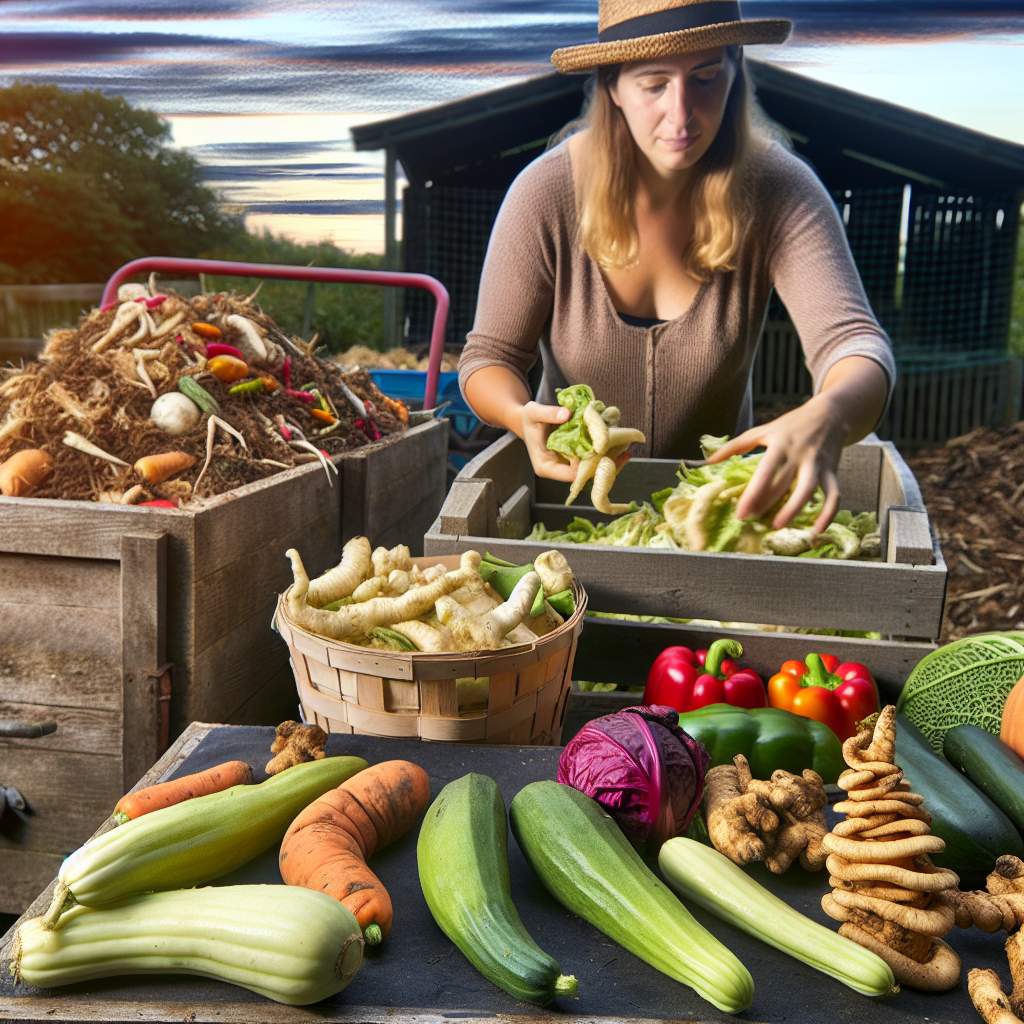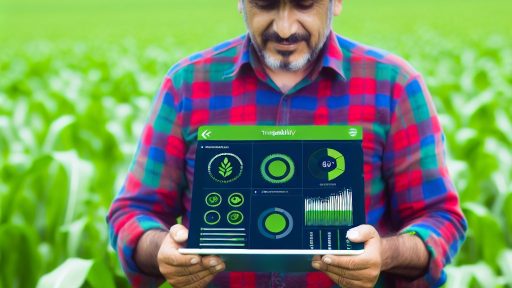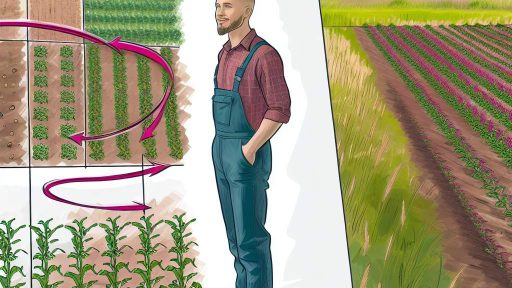Understanding Food Waste
Definition of Food Waste
Food waste refers to edible food that is discarded or not consumed.
It includes food that is lost during production, processing, and distribution.
Additionally, it covers food that is thrown away at retail and by consumers.
Importance of Reducing Food Waste
Reducing food waste is vital for sustainability in farm-to-market systems.
It conserves resources like water, energy, and labor used in food production.
Moreover, less food waste decreases greenhouse gas emissions from landfills.
Impact on Local Economies
Food waste significantly impacts local economies and farmers’ profits.
When food is wasted, farmers lose potential income from unsold products.
This loss can create economic instability in communities reliant on agriculture.
Encouraging Responsible Consumption
Reducing food waste encourages consumers to make mindful choices.
It fosters a culture of valuing food and understanding its resources.
Furthermore, it helps build awareness about food sustainability.
Fostering Community Engagement
Engaging communities in food waste reduction initiatives is essential.
Collaboration between producers, consumers, and local organizations can reduce waste.
This engagement cultivates a sense of shared responsibility for food resources.
Transform Your Agribusiness
Unlock your farm's potential with expert advice tailored to your needs. Get actionable steps that drive real results.
Get StartedIdentifying Key Stages of the Supply Chain Where Waste Occurs
Production Stage
During the production stage, waste often starts with planting decisions.
Farmers may plant too much, leading to excess crops.
Weather conditions can also impact yields negatively.
Improper harvesting methods can result in significant losses.
Using the right techniques can minimize this waste.
Processing Stage
The processing stage sees waste through poor handling and storage practices.
Fruits and vegetables may spoil due to inadequate refrigeration.
Incorrect processing procedures can lead to product degradation.
Implementing proper training for workers is essential.
Investing in efficient equipment helps reduce processing waste.
Transportation Stage
Transportation plays a crucial role in food waste management.
Delays during transport can result in spoilage.
Poor packaging can also lead to damages and losses.
Utilizing route optimization software enhances delivery efficiency.
By ensuring timely transport, producers can cut down on waste.
Retail Stage
The retail stage continues the cycle of waste generation.
Unsold products often end up discarded due to shelf life limits.
Effective inventory management helps to address this issue.
Offering discounts on nearing-expiry items encourages sales.
Collaboration with local food banks also reduces excess waste.
Consumer Stage
Consumers play a significant role in the food waste equation.
Improper storage practices at home contribute to food spoilage.
Educating consumers on meal planning can help reduce waste.
Encouraging mindful purchasing decisions leads to better outcomes.
Showcase Your Farming Business
Publish your professional farming services profile on our blog for a one-time fee of $200 and reach a dedicated audience of farmers and agribusiness owners.
Publish Your ProfilePromoting awareness about food waste can change consumer behavior.
Best Practices for Harvesting to Minimize Product Loss
Timing Your Harvest
Harvest at the right time to ensure peak quality.
Monitor crop maturity closely with regular checks.
Different crops require different harvest timelines.
Consult local agricultural experts for guidance.
Using Appropriate Tools
Utilize the right tools to prevent damage to crops.
Sharp knives and clean shears help maintain quality.
Invest in equipment that suits your specific crops.
Regularly maintain and replace tools as needed.
Employing Gentle Handling Techniques
Handle harvested products carefully to reduce bruising.
Train workers in proper handling methods.
Minimize tossing or dropping during transportation.
Use padded containers to protect delicate items.
Effective Sorting and Grading
Sort products immediately after harvest to identify defects.
Separate high-quality produce from less desirable items.
This practice helps maximize sale potential.
Utilize guidelines for quality grading based on market standards.
Storing Harvested Products Properly
Store crops in suitable conditions to extend shelf life.
Control temperature and humidity in storage areas.
Rotate stock regularly to use older items first.
Implement clear labeling for better inventory management.
Communicating with Markets
Establish good relationships with market buyers.
Communicate product availability and quality consistently.
Gather feedback to improve future harvest practices.
Stay adaptable to market shifts for better outcomes.
You Might Also Like: How Farm-To-Table Pop-Ups Strengthen Rural Farming Economies Across The USA
Storage Techniques: Maintaining Quality to Reduce Spoilage
Importance of Proper Storage
Proper storage techniques significantly reduce food spoilage.
These methods ensure the freshness and quality of produce.
Moreover, they extend the shelf life of products.
Understanding Temperature Control
Temperature control plays a vital role in storage.
Each type of produce has specific temperature requirements.
For instance, leafy greens thrive in cooler environments.
On the other hand, tropical fruits prefer warmer conditions.
Regularly monitor storage temperatures to prevent spoilage.
Humidity Levels Matter
Humidity also affects food quality and shelf life.
Fruits like apples release ethylene gas, impacting surrounding produce.
Utilize humidity controls in storage facilities when necessary.
Proper humidity can prevent wilting and dehydration.
Packaging Practices
Choosing the right packaging is essential for preservation.
Use breathable materials to reduce moisture buildup.
Showcase Your Farming Business
Publish your professional farming services profile on our blog for a one-time fee of $200 and reach a dedicated audience of farmers and agribusiness owners.
Publish Your ProfileAvoid plastic wraps that trap humidity.
Consider using cardboard boxes or mesh bags for ventilation.
FIFO Practice: First In, First Out
Implementing the FIFO method is crucial in storage systems.
Ensure older stock is used before newer arrivals.
This practice helps in minimizing waste effectively.
Label products with dates to facilitate this process.
Regular Inspection and Maintenance
Conduct regular checks on stored produce.
Look for signs of spoilage or pest infestations.
This proactive approach helps maintain optimal quality.
Additionally, it allows for timely actions to mitigate losses.
Investing in Technology
Utilize technology for better storage management.
Monitoring systems can provide real-time data on conditions.
Automated alerts help in maintaining proper temperature and humidity.
Investing in such technologies pays off in improved efficiency.
Gain More Insights: Biodiversity in Farming for Agroforestry Integration
Transport Innovations: Ensuring Product Integrity During Distribution
Importance of Transport Innovations
Transport innovations play a crucial role in reducing food waste.
They ensure products reach consumers in peak condition.
Furthermore, these advancements enhance overall supply chain efficiency.
Innovative Transport Methods
Adopting new transport methods can mitigate waste significantly.
For example, refrigerated trucks maintain optimal temperatures during transit.
Additionally, using lightweight materials in packaging can reduce transportation costs.
- Consider electric vehicles for eco-friendly transport.
- Utilize drones for quick delivery in urban areas.
- Implement automated systems for inventory management.
Best Practices for Ensuring Product Integrity
Following best practices in transport is essential for all producers.
Always use proper handling techniques to minimize damage.
Label products clearly to facilitate easier tracking and quicker distribution.
Moreover, regular maintenance of transport vehicles is vital.
Monitoring and Data Collection
Utilizing technology for monitoring food during transport can help prevent waste.
Implement GPS tracking to assess real-time conditions and locations.
Moreover, train staff on the importance of data collection.
Gathering data can generate insights for future improvements.
- Use temperature sensors to monitor perishables.
- Regularly review transportation routes for efficiency.
- Assess end-to-end supply chain processes.
Gain More Insights: Farm-to-Restaurant Programs for Heirloom and Heritage Crops

Consumer Education: Promoting Proper Handling and Usage of Fresh Produce
Importance of Consumer Education
Consumer education plays a vital role in reducing food waste.
By informing individuals, we can promote awareness about fresh produce.
Furthermore, consumers learn how to handle and store food properly.
Proper Handling Techniques
First, always wash your hands before handling fresh produce.
Next, rinse fruits and vegetables under running water.
Use a clean brush for scrubbing hard-skinned produce.
Additionally, avoid washing produce until ready to use.
Storage Guidelines
Storing produce correctly is essential for freshness.
Refrigerate fruits and vegetables that require cooler temperatures.
Store ethylene-producing fruits away from sensitive vegetables.
Showcase Your Farming Business
Publish your professional farming services profile on our blog for a one-time fee of $200 and reach a dedicated audience of farmers and agribusiness owners.
Publish Your ProfileMoreover, keep produce in breathable bags to maintain ventilation.
Utilizing Leftover Produce
Using leftover produce can significantly reduce waste.
Consider making smoothies with overripe fruits.
Also, incorporate wilted vegetables into soups and stews.
Finally, freeze excess produce for later use in cooking.
Educating Through Community Programs
Community programs can enhance consumer education efforts.
Workshops on proper food handling can be beneficial.
Additionally, share recipes that utilize leftover ingredients.
These initiatives encourage sustainable practices among consumers.
Delve into the Subject: Permaculture Practices for Organic Crop Rotation Systems
Utilizing Technology: Apps and Tools for Monitoring and Managing Food Waste
Importance of Technology in Food Waste Reduction
Technology plays a crucial role in reducing food waste.
It enables producers to monitor their inventory effectively.
Additionally, it helps track food freshness and spoilage.
Thus, embracing technology leads to improved decision-making.
Essential Apps for Food Waste Management
Several apps are available to assist producers in monitoring waste.
One notable example is “Waste No Food.”
This app connects food donors with local food agencies.
Another useful tool is “Too Good To Go.”
This platform allows businesses to sell surplus food at discounted prices.
Tools for Inventory Tracking
Inventory management tools can streamline operations.
For instance, “FreshTrack” provides real-time inventory insights.
It helps producers understand product turnover rates.
Consequently, managers can make informed orders and reduce waste.
Technology for Educating Producers
Education is vital in utilizing technology effectively.
Platforms like “HarvestMark” offer training on food waste reduction.
These platforms provide resources on best practices.
Moreover, they share insights on consumer behavior and trends.
Integrating Technology with Sustainable Practices
Integrating technology supports sustainable farming practices.
For example, precision agriculture helps minimize resource waste.
This approach promotes both efficiency and sustainability.
Furthermore, it encourages data-driven decision-making.
Future Trends in Food Waste Technology
The future of food waste management looks promising.
Emerging technologies like blockchain can enhance transparency.
Additionally, artificial intelligence can predict waste patterns effectively.
As these technologies evolve, their application will expand.
Ultimately, they will play a critical role in food sustainability.
Collaboration Opportunities: Working with Local Organizations to Promote Waste Reduction
Identify Local Organizations
Start by identifying local organizations focused on sustainability.
Consider non-profits, farmers’ markets, and community groups.
These entities work directly with producers and consumers.
They often run waste reduction initiatives and educational programs.
Showcase Your Farming Business
Publish your professional farming services profile on our blog for a one-time fee of $200 and reach a dedicated audience of farmers and agribusiness owners.
Publish Your ProfileBuild Partnerships
Reach out to these organizations to discuss collaboration.
Building partnerships creates a stronger impact on waste reduction.
Combine resources to offer workshops and training sessions.
Engaging with local organizations can enhance visibility and outreach.
Share Best Practices
Organize meetings to share best practices in waste management.
These exchanges foster learning and innovation among producers.
Collective experiences can lead to more effective waste reduction strategies.
Document successful practices to serve as a resource for others.
Participate in Community Events
Join community events focused on sustainability.
Use these platforms to promote your waste reduction efforts.
Engagement can help raise awareness about food waste issues.
Collaborative events can facilitate networking opportunities.
Leverage Social Media
Utilize social media to amplify your waste reduction message.
Share events and initiatives with your followers.
Encourage organizations to cross-promote your efforts.
Increasing visibility can attract more community involvement.
Measure and Report Outcomes
Track progress of collaborative efforts in waste reduction.
Regular reporting can help adjust strategies as needed.
Sharing outcomes builds trust and accountability with partners.
It also highlights the impact of collective actions in the community.
Additional Resources
From Farm to Kitchen: The Environmental Impacts of U.S. Food Waste




